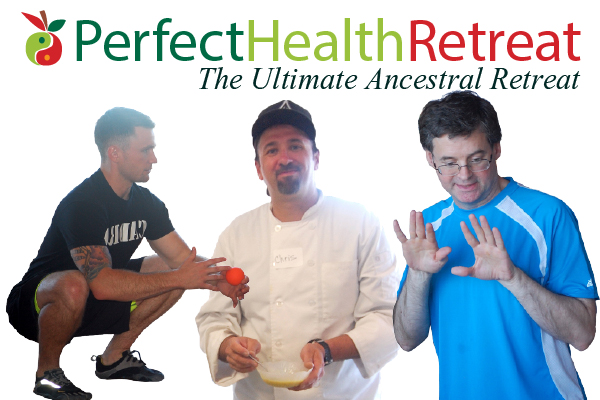As part of the Buck Books Weight Loss Event, you can buy North American ebook editions (Kindle, Nook, etc) of Perfect Health Diet all day Tuesday for just 99 cents. Link:
If you haven’t yet bought a copy of the book – you should! We never repeat book content on the blog, so even if you’ve read all our blog posts, you’ll find lots of new material in the book.
And the book’s advice produces excellent results. Here is a sampling of recent Amazon reviews (last 6 months) in which readers mention their health results:
- This diet works really well for me. My energy level has increased.… I also have a more positive relationship with food now…. It is the least restrictive diet I’ve come across. – sdstudent619
- The diet is working out great – ended up with the lowest triglycerides of my entire adult life for my physical exam bloodwork after only a couple of months! – Dan Chung
- The foods I crave and love most are central to this healthy way of gaining proper nutrition. Not so strange as it sounds now that I understand the science behind it. – Jo J Pihl
- I lost over 15lbs – and I was not even trying to lose weight – I was just trying to improve my overall health. Never thought about watching calories through the process. My weight settled into a nice range and has stayed there without effort for months so far. – Gene
- I have made many changes in my diet based on the recommendations in this book, and I already see positive results, such as clearer thinking. – A. Lee
- I feel better, have lost weight and believe I’m smarter about what I eat because of this book. – Jberto
- As a Biologist I DO heartily recommend this book…. Your body will start reacting almost immediately (within days) for the better and at last will be totally satisfied (which is the reason cravings will be eliminated). – Annemieke Akker
- This book is great. I’ve been on the diet for about two months and have already lost ten pounds, and I feel a lot healthier. – Taylor
- Lost already 12 pounds in 6 weeks. Simple advice with big impact. – Charlie
- I have been waiting for this book all my life. I have tried every diet with no success. I knew there had to be a diet that was nourishing but also did not create constant cravings. I have been on this diet for just a few days, but already feel much better and have less cravings. – Healthy pursuit
- I have been low carb for a couple of years but after the first 40 #s I am just stuck…. After I got the book I started immediately with adding potatoes and rice and lost 2 # this week. – Mary Joe Fant
- It’s been said before…but it really is the sanest book on health. No exaggeration or gimmicky ideas, just very sound and practical information that completely makes sense. I am rereading for the fourth or fifth time and still having dozens of epiphanies. This is one book I am buying for as many loved ones as I can convince to accept it. I started on zero-carb, lean-meat-and-veg Paleo, and became painfully thin and developed some health problems, and now I have gained weight, but in a good way–I get some compliments on looking toned or, once, to my surprise and delight, like a runner (though I exercise little). And I have fixed several other problems. I am just dying to give this to everyone … I really can’t understand how this book is not the most popular health book in existence. – Mallory Osugi
- Great info on healthy nutritious eating. My weight gain stopped and I have more than enough energy to exercise. I don’t feel constantly starved or missing smth. – Amazon customer
- What a good book. I`ve had problems with my body weight for almost 7 years – lost quite a few kilos after a fast and could never regain them back /so I`ve been underweight for all this time/. What`s more, if had a flu and lose lets say half a kilo – I couldn`t get it back. And that has been going on since 2007. Had several lots of medical tests – nothing wrong could be found apart from chronic gastritis (NOT H. pylori). I`ve tried numerous supplements, numerous dietary modifications, gym, gym+calorie counting – probably everything that sounded reasonable/without being stupid:)/- unfortunately nothing worked. I was forcing myself to eat large portions 4-5 times a day just to hear comments from my friends how skinny I was and that I was probably not eating enough (a friend told me ones that if I was kept on going the way I did I would probably disappear at some point in the near future). My energy level was also quite low – something that was never the case before 2007. Anyway – in January this year I dropped down to 60kg /on 176 cm frame/ and at that point I came across the book ‘Perfect health diet’. As soon as i got onto the diet I started putting on about a half a kilo per a week until i reached my perfect weight ~ 74kg/ of course I was going to a gym as well/. My energy level skyrocketed and I was able to do harder workouts compare with when I was a student 16-17 years ago. So in my case – the diet worked and I would highly recommend it (I used Macadamia nut oil as a staple oil – the highest in Monounsaturates and relatively low on saturates( read tons of literature about the saturates – there is still some controversy:)/ and fish as main source of protein /I dont really like meat/. The theory in the book makes pretty good sense – the evolutionary theory, the body needs for Carbs/Proteins/Fat ect. Some of the studies quoted can be questioned but still you can find others on pubmed that back up the theory. Overall – highly recommended book! — Nikolay K.
- I just wanted to let people know that this is one of the best books ever written and should be taught in schools. It has changed my life for the better and you will see results straight away if you follow it. — Floyd Woolley
- I’ve lost a fair amount of weight after reading this book and am feeling a lot better as well. – Wilmer (UK)
- Life Changing!! At last a real understanding of how we Should see food. I’ve lost 14Lbs in 4weeks and my energy levels have improved, the recipes are tasty and would recommend this way of eating to be for life, not just for christmas (or after it). — Mark Barnes-Williams
- Excellent Athletic Diet. So many Paleo or predominantly health centred diets largely neglect many aspects of diet that are needed for athletic performance, focussing solely on longevity, weight loss and chronic illness. Whilst the PHD covers all these areas extremely well it also tailors its advice for users wanting to compete at a high sporting level and use diet to optimise performance. So far the PHD has done this for me, all my performance based markers have improved and in the last month my bodyweight has increased by 7 lbs. It really is perfect. – Ryan Mounsey
Enjoy, and thank you to all readers who leave Amazon reviews!













Recent Comments